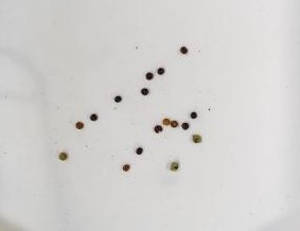By Bob Hartzler
Problems caused by unfavorable conditions this season have resulted in greater than normal weed escapes. These weeds may reduce crop yields and definitely will contribute to future weed problems via new seed. While it is too late to protect crop yields, a common question is whether herbicides can be used to reduce the quantity of viable weed seed produced by weeds. While there is no simple answer due to the many different scenarios across the state, in most situations late-season applications are not warranted.
The potential to limit seed production is affected by two main factors: 1) susceptibility of the weed to the herbicide, and 2) stage of seed development at the time of application. It is important to recognize that herbicides that are effective early in the season will be much less, if at all, effective on the mature weeds in fields now. Waterhemp is unlikely to be killed by any labeled herbicides at this time of the year. While other species may be killed with herbicides, the impact on seed production will be highly variable.
Research in the early 1980’s looked at the effect of late-season 2,4-D applications in corn on seed production by velvetleaf and cocklebur (the 1980’s equivalent of today’s waterhemp). While brown-silk 2,4-D applications were able to kill both species, the treatments were much more effective at preventing seed production by cocklebur than velvetleaf. Much of the velvetleaf seed had filled by the time of the 2,4-D application, whereas cocklebur was still in early flowering stage. Seed that had filled prior to 2,4-D retained their viability even if the parent plant was killed prematurely. Before committing to any late-season treatments, examine weeds to determine the stage of seed development. Both waterhemp and giant ragweed present in fields in central Iowa had fully developed seed during the week of August 26 (Fig 1 and 2). The 2,4-D label for late-season applications was changed in the 1980's from after brown-silk to after the dent stage, this change will reduce the effectiveness of the treatments since it provides more time for weed seeds to mature.

Figure 1. Waterhemp seed, Aug 29.
Figure 2. Giant ragweed seed, Aug 29.
Reducing weed seed production is essential in order to minimize the seed bank. By reducing the size of the seed bank, future weed management will be simplified and the risk of new herbicide resistant biotypes will be reduced. However, late-season herbicide applications are unlikely to provide significant benefits for most fields. Hand pulling weeds is an alternative, but at this time of year the plants would need to be removed from the field. In situations where a patch of a weed is present that is suspected to possess a new resistant trait for that field, removal of the weeds probably would be worth the effort. Rather than spending money on a questionable treatment, spend time determining why this year’s program failed and develop an effective weed management plan for 2020.